This may be a very unusual situation… then again maybe not. My school district is in the process of training each school how to manage iPads with a MacBook using Apple Configurator. We scheduled a staff member from each school to come to one school and work with their Macbook in groups of about 40 at a time. In the process of installing the Supervision certificate on the iPads, configurator will always install a version of iOS. It will try to convince you to connect to Apple’s servers and use the “latest” but you can point it to any version of the iOS you happen to have on the Mac.
With 40 devices trying to download the full iOS 5.1.1 we found that roughly half of the computers were getting errors when they tried to get the iOS off the network. Not exactly sure why, but we needed a solution quick to get these people set up and trained. So I updated the iOS in iTunes by plugging in one iPad on a Macbook. I then found the file for iOS 5.1.1 by revealing hidden folders using these terminal commands:
___________________
defaults write com.apple.Finder AppleShowAllFiles TRUE
Then:
killall Finder
___________________
Then I navigated to the file here:
User/Library (hidden)/iTunes/iPad Software Updates/ filename.ipsw
I then copied the file onto a usb drive and sent it around the room. They were able to install this one version of the iOS onto EACH iPad in the room without needing to download the iOS onto each Mac. Seeing as the iOS 5.1.1 is over 700 MB that is a significant bandwidth suck! It appears that the Mac still needs a network connection in order to check the validity of the file, but you don’t have to download it.
Of corse afterwards it is good to go to that Mac and hide the hidden files again.
___________________
defaults write com.apple.Finder AppleShowAllFiles FALSE
(press up arrow twice and delete TRUE and type FALSE and hit enter)
Then:
killall Finder
(press up arrow twice and hit enter)
___________________
Life is good when your students are not sitting around waiting for software to download.
Lesson learned? Whenever possible, download any files you can to put on the Macs before getting students in the room. I know the App files we needed to pull into Configurator could NOT be downloaded ahead of time due to the Apple ID’s are unique for each of the paid apps and are signed with that ID. But the iOS, as I learned today is not l and can be transfered across multiple Macs and iPads!




